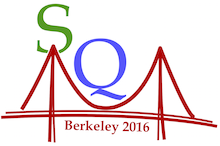Speaker
Lukasz Kamil Graczykowski
(Warsaw University of Technology (PL))
Description
Femtoscopy is a technique allowing measurements of the space-time characteristics of particle production using correlations arising from the effects of quantum statistics and final state interactions. In AA collisions, the measurements of pions, kaons, and protons can be employed to test the hydrodynamic evolution of the system. In this talk we present the ALICE results for all three particle species in PbPb collisions at $\sqrt{s_{\mathrm{NN}}}$=2.76 TeV. In particular, the measured 3D kaon radii were compared with a model where the hadronic rescattering phase succeeds the hydrodynamic phase and a model with hydrodynamic-only stage. The $m_{\mathrm{T}}$ scaling of pion and kaon radii, due to radial flow, is predicted by the latter model; however, the ALICE data show the breaking of the scaling indicating strong rescattering in the hadronic phase.
The femtoscopic formalism is also sensitive to the interaction kernel for a pair of particles, which is directly related to pair interaction cross-section. We show the first measurements of K$^{0}_{s}$K$^{\pm}$ correlation functions in PbPb collisions. These correlations originate from the final-state interactions which proceed through the a$_{0}$(980) resonance. The ALICE data show that the a$_{0}$ final state interaction describes the measured correlation well. The radii extracted from K$^{0}_{s}$K$^{-}$ and K$^{0}_{s}$K$^{+}$ systems are found to be equal within uncertainties. The results are also compared with those from ALICE identical-kaon measurements and the parameters of the a$_{0}$ resonance are constrained.
The same approach can be applied to baryons to extract the cross-section of the baryon-(anti)baryon interactions. We will show preliminary results from baryon correlations, including protons and $\Lambda$s. The extraction of the cross-sections is complicated by the presence of the so-called "residual correlations" originating from the weak decay products. A fitting method accounting for these residual correlations is employed in the case of p-p, p-$\overline{\mathrm{p}}$ and $\overline{\mathrm{p}}$-$\overline{\mathrm{p}}$ correlations.
| On behalf of collaboration: | ALICE |
|---|
Author
Lukasz Kamil Graczykowski
(Warsaw University of Technology (PL))
